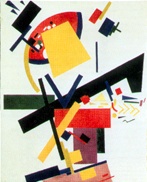The first two decades of the last century were a period of frantic creativity and turmoil. The destruction of previous norms and expectations in all areas of life had a huge impact on all the arts in all countries. In 1913, Wassily Kandinsky wrote that "the disintegration of the atom was to me like the disintegration of the whole world." Like many other artists he expressed this new perception of things with a new aesthetic, one that dissolved the previous sense of a solid material reality - with the help of music, the least solid of all the arts.
A new exhibition, on display at the Schoenberg Centre in Vienna until 28 May, demonstrates the international nature of the turmoil of early modernism by bringing together the artists who were associated with Kandinsky, Schoenberg and the other members of the avant garde who clustered together around the name Der Blaue Reiter (the Blue Rider).
Extravaganza of expression
The Blaue Reiter was a formation of artists that first exhibited their work together in 1911 and also produced Der Blaue Reiter Almanach in 1912, one of the ground-breaking manifestos of the modernist movement in art, music and painting that sprang up in the years before the First World War.
The exhibition in Vienna is comprised of over 120 oil paintings and 80 manuscripts, water colours and drawings. Some of these belong to the Schoenberg Centre itself, but most are on loan from other institutions throughout Europe.
The inclusion of many important paintings by Russian artists who were associated with Kandinsky and the Blaue Reiter is the result of a co-operation between the Schoenberg Centre and the Russian Museum in St Petersberg. Many of these have not been seen in the West before, and the fact that they hang beside those of Arnold Schoenberg, Wassily Kandinsky, Franz Marc and the other members of the Blaue Reiter is a demonstration of the renewal of cultural unity between Western Europe, Eastern Europe and Russia.
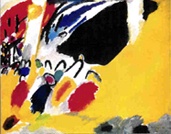 |
| Kandinsky: Impression 111 (Koncert) |
While the first of these exhibitions, held in December 1911, signalled a break with the new but comparatively conservative art of the Neue Kunstlervereinigung of Munich, the second one, held in March 1912, assembled the work of the main representatives of the modern art world, in a bid to show that the Blaue Reiter's progression towards abstract art was central to the wider developments that were sweeping Europe and Russia at the time.
In this second exhibition, the French cubism of Braque, Derain, Picasso and Maurice de Vlaminck hung alongside the German Expressionist painting of Die Brücke and the painters of the Russian avant garde that had already made inroads into abstraction in art. This exhibition travelled all over Germany, until the war disrupted the momentum of Kandinsky's iconoclastic promotion of modern art.
Sounds into images
An important ingredient of the new movement was the idea that painting could become like music; an idea that led to the composer Arnold Schoenberg (who was himself an innovatory painter) becoming central to the consolidation of Kandinsky's and Marc's Blaue Reiter aesthetic. After a concert of Schoenberg's music in January 1911, Kandinsky established contact with the composer, and the two wrote and collaborated intensively for the next few years.
The painting Kandinsky did after this 1911 concert is one of many of Kandinsky's works on display in the rooms of the Schoenberg Centre. Entitled Impression 111 (Koncert) it exploits bright colours and bold shapes, which are expressive in their own right without references to the outside world distracting from their immediate effect. In this work, it is just possible to make out the shape of a grand piano and the audience of people sitting around it.
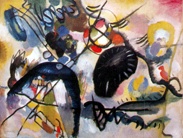 |
| Kandinsky: Black Spot |
Although Kandinsky was the first artist to break into abstraction in its most extreme form (his first abstract painting was in 1910), many of his fellow countrymen who had stayed in Russia were not far behind. For example, the artist Mikhail Larionov painted his first abstract work in 1911. Also, Robert Delaunay and Frank Kupka in Paris found their way to abstraction quite independently of the Russians. By 1915, the movement was well under way and in this exhibition there are many examples of painting that functions like music in its capacity to express emotion through pure form and colour.
Kasimir Malevich's Suprematism of 1915 (see top image) is one such painting that is part of this exhibition. Constructed of geometric shapes, it creates a painterly rhythm, as the shapes and colours clash and interact with one another.
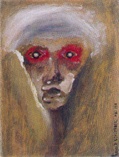 |
| Schoenberg: Red Gaze |
A friendship of rule-breaking
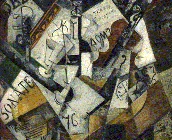 |
| Udalzova: Still Life-Musical Instruments |
One of these is the story of the relationship between Kandinsky and Schoenberg (told by means of a computer generated slide show), and the remarkable aesthetic congruence that is revealed by their letters. The simultaneous discovery of atonal music and abstract art is revealed in the story of the friendship between these two men, a friendship that led to Schoenberg's visit to St Petersburg in 1912, where he conducted his orchestral tone poem Pelleas and Melisande at the invitation of Tchaikovsky's pupil, Aleksander Siloti.
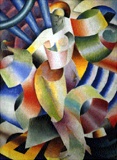 |
| Baranov-Rossine: Christiniija Fjord |
Perhaps the most interesting story of all is that told by the paintings themselves, as they are grouped together in the rooms of the Schoenberg Centre as a demonstration of the rich network of artistic friendships and professional influences that stretched from Paris, across Europe and beyond, to Russia.
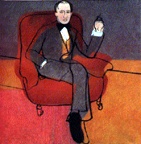 |
| Miturich: Portrait of Arthur Lourié |
There are echoes of Matisse in the economical linear style of Piotr Miturich's portrait of Arthur Lourié (1915) and the more abstract Composition - Peasant painted by Aleksander Naumov in 1920.
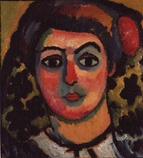 |
| Jawlensky: Lola |
Painting music
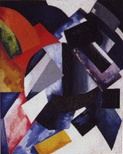 |
| Ekster: Non-Objective Composition |
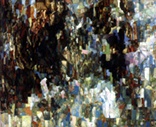 |
| Filonov: White Painting |
As Schoenberg wrote to Kandinsky during the most intensive period of their aesthetic collaboration, "Every formulation that strives for traditional effects is not completely free of conscious acts. But art belongs to the unconscious!"
With all the works shown in this exhibition, wherever they were painted, it is the attempt to allow art to spring from the well of the "unconscious" and by-pass the logic and reason of reference and representation that unifies the various styles, groups and nationalities that are represented here.
Sue Bagust, 24 April 2000
Other articles of interest:
- The Forgotton Avant Garde:
Soviet composers crushed by Stalin
(Andrew James Horton) - Zaum and Sun
:
The "first Futurist opera" revisited
(Isobel Hunter) - The St Petersburg Legacy
:
Portrait of a city through its avant garde
(Andrew James Horton)
Moving on:
More information:
The catalogue that accompanies the exhibition has an extensive collection of essays and is illustrated fully with all the paintings in the exhibition.
It is available from:
The Arnold Schoenberg CentreThe catalogue also forms the Journal of the Arnold Schoenberg Centre, Vol. 1/2000
Zaunergasse 1
1030 Vienna
Further information is available from the Centre's web site.



